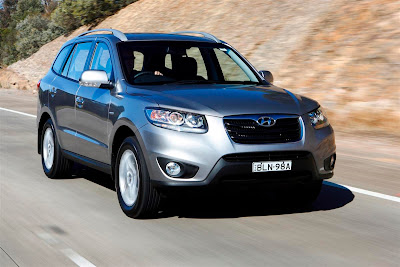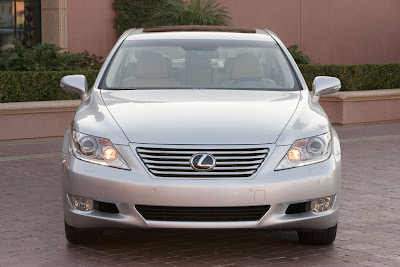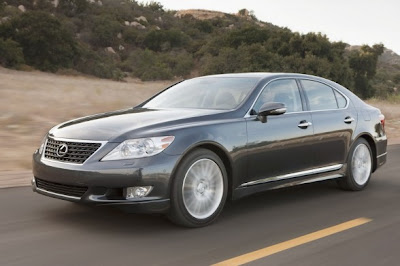mercedes benz ml63 amg
mercedes benz ml63 amgmercedes benz ml63 amgmercedes benz ml63 amg wallpapersmercedes benz ml63 amgmercedes benz ml63 amg pictures
audi q7
audi q7audi q7 wallpapersaudi q7audi q7 picturesaudi q7
bentley continental gt
bentley continental gtbentley continental gt wallpapersbentley continental gtbentley continental gt wallpapersbentley continental gt
Korean Faux Hawk Hairstyle
mercedes benz sl65 amg
mercedes benz sl65 amgmercedes benz sl65 amg wallpapersmercedes benz sl65 amgmercedes benz sl65 amgmercedes benz sl65 amg wallpapers
acura integra
acura integraacura integraacura integra wallpapersacura integra photoacura integra
audi a3
audi a3audi a3 wallpapersaudi a3audi a3audi a3 pictures
aprilia
apriliaaprilia picturesapriliaaprilia wallpapersaprilia
alfa romeo
alfa romeo wallpapersalfa romeoalfa romeo picturesalfa romeoalfa romeo wallpapers
Concept Cars: Hyundai Genesis Coupe
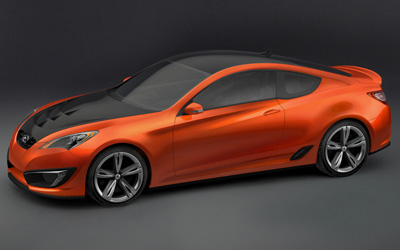
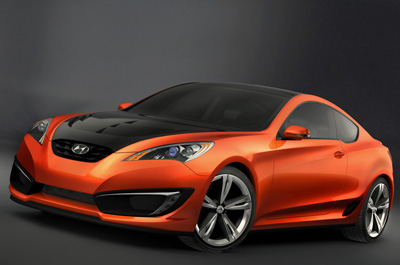
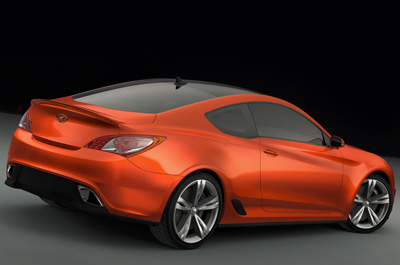
| Make | Hyundai |
| Model | Genesis Coupe |
| Concept year | 2007 |
| Production year | 2009 |
| Engine | - |
The Hyundai Genesis Coupe was unveiled at the 2007 Los Angeles Motor Show. The Genesis Coupe concept is a preview of the RWD, 2+2 sports Hyundai coupe intended to go on sale in 2009.
Engine options for the Hyundai Genesis Coupe concept are reputed to include a turbocharged four cylinder unit and a 3.8 litre V6. Horsepower for the top spec model should be in the 300 hp range.
The Hyundai Genesis Coupe's styling is based in part on that of the HCD8 concept from 2004.
Concept Cars: Hyundai Genesis Coupe



| Make | Hyundai |
| Model | Genesis Coupe |
| Concept year | 2007 |
| Production year | 2009 |
| Engine | - |
The Hyundai Genesis Coupe was unveiled at the 2007 Los Angeles Motor Show. The Genesis Coupe concept is a preview of the RWD, 2+2 sports Hyundai coupe intended to go on sale in 2009.
Engine options for the Hyundai Genesis Coupe concept are reputed to include a turbocharged four cylinder unit and a 3.8 litre V6. Horsepower for the top spec model should be in the 300 hp range.
The Hyundai Genesis Coupe's styling is based in part on that of the HCD8 concept from 2004.
Concept Cars: Hyundai Blue-Will
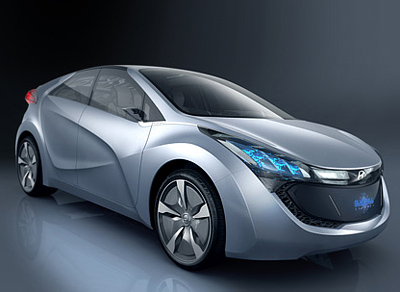
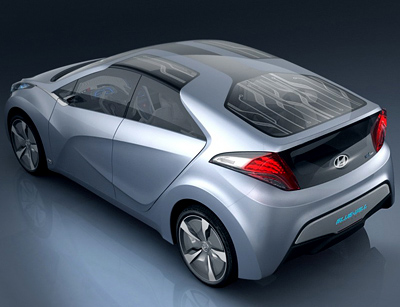
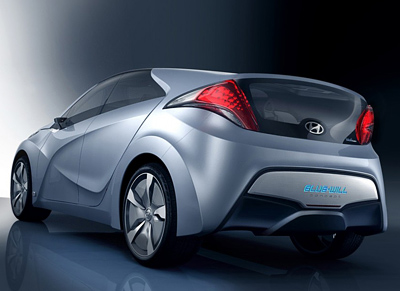
| Make | Hyundai |
| Model | Blue-Will |
| Concept year | 2009 |
| Production year | - |
| Engine | 1.6 litre petrol and electric motor hybrid |
The Hyundai Blue-Will concept is a all-new concept car which was first revealed at the 2009 Seoul Motor Show.
The Blue-Will is a plug-in rechargeable hybrid powered concept which uses an all-aluminium Gasoline Direct Injected 1.6-litre engine coupled to a CVT (Continuously Variable Transmission) and a 100kw electric motor for propulsion. The Lithium Ion Polymer battery pack is located near the fuel tank under the rear seat to maximize luggage space. To help top up the power levels in the battery pack the Blue-Will is equipped with solar panels stylishly integrated into the roof panels and rear window.
Aside from the power source the Hyundai Blue-Will concept also utilizes recycled materials to help reduce its impact on the environment. The headlight bezels were formed from recycled plastic drinks bottles, while the interior features numerous components which are made using Polylactide acid (PLA) plastics. PLA is a plastic produced from cane sugar or corn starch and has the benefit of being both easily processed and manufactured while also being biodegradable at the end of its lifespan. The Blue-Will also uses components made from PA 11 plastic, this compound, while not biodegradable requires less energy during production than standard plastics.
The exterior design of the Hyundai Blue-Will is both futuristic and at the same time feasible for production. The crisp styling lines which intersect on the front door define the overall style of the vehicle and lend the concept an almost Seat-like styling quality.
Concept Cars: Hyundai Blue-Will



| Make | Hyundai |
| Model | Blue-Will |
| Concept year | 2009 |
| Production year | - |
| Engine | 1.6 litre petrol and electric motor hybrid |
The Hyundai Blue-Will concept is a all-new concept car which was first revealed at the 2009 Seoul Motor Show.
The Blue-Will is a plug-in rechargeable hybrid powered concept which uses an all-aluminium Gasoline Direct Injected 1.6-litre engine coupled to a CVT (Continuously Variable Transmission) and a 100kw electric motor for propulsion. The Lithium Ion Polymer battery pack is located near the fuel tank under the rear seat to maximize luggage space. To help top up the power levels in the battery pack the Blue-Will is equipped with solar panels stylishly integrated into the roof panels and rear window.
Aside from the power source the Hyundai Blue-Will concept also utilizes recycled materials to help reduce its impact on the environment. The headlight bezels were formed from recycled plastic drinks bottles, while the interior features numerous components which are made using Polylactide acid (PLA) plastics. PLA is a plastic produced from cane sugar or corn starch and has the benefit of being both easily processed and manufactured while also being biodegradable at the end of its lifespan. The Blue-Will also uses components made from PA 11 plastic, this compound, while not biodegradable requires less energy during production than standard plastics.
The exterior design of the Hyundai Blue-Will is both futuristic and at the same time feasible for production. The crisp styling lines which intersect on the front door define the overall style of the vehicle and lend the concept an almost Seat-like styling quality.
Concept Cars: Hyundai Nuvis
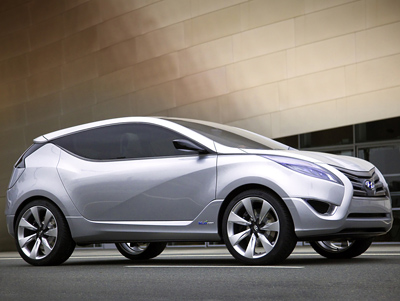


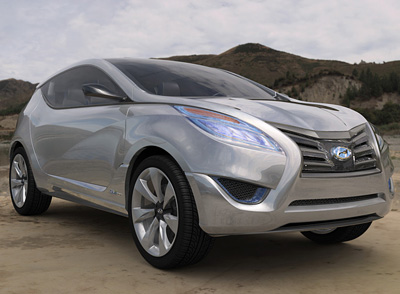

| Make | Hyundai |
| Model | Nuvis |
| Concept year | 2009 |
| Production year | - |
| Engine | hybrid |
The Hyundai Nuvis concept was one of the vehicles displayed at the 2009 New York Motor Show. The Nuvis was designed at Hyundai's American design center in Irvine, California and is intended to preview a possible future design direction for the next-generation of crossover vehicles from the manufacturer.
The exterior styling of the Nuvis was partially inspired by the way water moves and flows around the hull and sides of a boat, creating a wake, and the way wind shapes a snowdrift or sandune.
"Our goal was to create a living machine, constantly moving, that the driver and passengers could be part of," said John Krsteski, Hyundai Design manager. "There are no lines on or in this car that are standing still." The bold face of the Nuvis concept is dominated by the large central grille and elongated diamond-shaped headlights.
"One of the coolest attributes of Nuvis is that the protective roof appears to float on top of the body through the use of hidden pillars and high-contrast glass," said Andre Hudson, Hyundai senior designer. "This effect starts at the headlamps and is carried all the way through to the taillights producing a tall, strong body-side and rear."
Perhaps the most striking and unusual design feature of the Hyundai Nuvis are the massive gullwing doors which, when open, provide a completley unobstructed view of the interior.
In keeping with the exterior design theme, the interior of the Nuvis is dominated by a striking blue acrylic center stack that ebbs and surges like a river. The four sculptured, comfortable seats are custom woven with a graduated fabric that is formed from 100% recyled plastic drinks bottles. A futuristic infotainment system is fed by outside sources – the occupants, for example, can learn of a restaurant's specials that evening as they drive past it.
Powering the Hyundai Nuvis concept is a hybrid drivetrain which consists of a fuel effcient 2.4 litre engine and a 30kW (205 Nm) electric motor.
Concept Cars: Hyundai Nuvis





| Make | Hyundai |
| Model | Nuvis |
| Concept year | 2009 |
| Production year | - |
| Engine | hybrid |
The Hyundai Nuvis concept was one of the vehicles displayed at the 2009 New York Motor Show. The Nuvis was designed at Hyundai's American design center in Irvine, California and is intended to preview a possible future design direction for the next-generation of crossover vehicles from the manufacturer.
The exterior styling of the Nuvis was partially inspired by the way water moves and flows around the hull and sides of a boat, creating a wake, and the way wind shapes a snowdrift or sandune.
"Our goal was to create a living machine, constantly moving, that the driver and passengers could be part of," said John Krsteski, Hyundai Design manager. "There are no lines on or in this car that are standing still." The bold face of the Nuvis concept is dominated by the large central grille and elongated diamond-shaped headlights.
"One of the coolest attributes of Nuvis is that the protective roof appears to float on top of the body through the use of hidden pillars and high-contrast glass," said Andre Hudson, Hyundai senior designer. "This effect starts at the headlamps and is carried all the way through to the taillights producing a tall, strong body-side and rear."
Perhaps the most striking and unusual design feature of the Hyundai Nuvis are the massive gullwing doors which, when open, provide a completley unobstructed view of the interior.
In keeping with the exterior design theme, the interior of the Nuvis is dominated by a striking blue acrylic center stack that ebbs and surges like a river. The four sculptured, comfortable seats are custom woven with a graduated fabric that is formed from 100% recyled plastic drinks bottles. A futuristic infotainment system is fed by outside sources – the occupants, for example, can learn of a restaurant's specials that evening as they drive past it.
Powering the Hyundai Nuvis concept is a hybrid drivetrain which consists of a fuel effcient 2.4 litre engine and a 30kW (205 Nm) electric motor.
Concept Cars: Hyundai ix-Metro
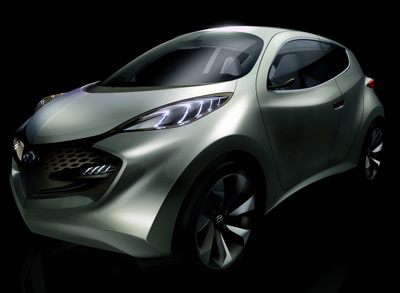
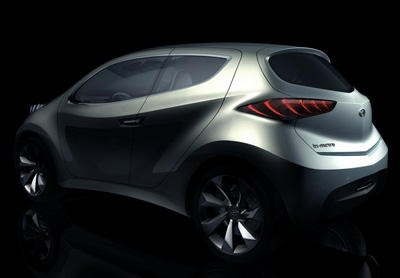

| Make | Hyundai |
| Model | ix-Metro |
| Concept year | 2009 |
| Production year | - |
| Engine | Hybrid petrol-electric, 1.0 litre, 3-cylinder, turbo |
The Hyundai ix-Metro is a Hybrid Electric CUV (Compact Utility Vehicle) designed to compete in the European sub-B segment. The ix-Metro is the fifth concept in a series of vehicles created by Hyundai's Global Design Team based in Namyang, South Korea.
The ix-Metro's hybrid drivetrain consists of a 1.0 litre, turbocharged three-cylinder engine with direct injection and dual CVVT (Continuous Variable Valve Timing). This is combined with a six-speed dual clutch transmission, and an electric motor. With its frugal drivetrain the Hyundai ix-Metro promises CO2 emissions of just 80g/km.
The styling of the ix-Metro is daring to say the least. This is in part due to the design influences. "We wanted the ix-Metro to be something out of this world. We took our inspiration from NASA and even sci-fi movies because spacecraft are universally understood symbols of progress and innovation," explained Rogelio J. Flores, Chief designer on the ix-Metro project.
The front has a gaping and aggressive grille which would not look out of place on a high-powered sports vehicle. Of particular interest are the unique ice-blue LED headlights which have a distinctive scale-like design motif, this design cue is carried over to the taillights.
In profile the ix-Metro shows off its four doors, however due to the positioning of the door handles and the apparent lack of any B-pillars, at first glance it appears to be a two-door vehicle.
Instead however it has conventional front doors, while the rear doors slide backwards to allow access to the rear sears. The pillar less design not only enlarges the greenhouse to improve all-round visibility, but more importantly allows easier entry and egress into the rear passenger area.
The interior of the Hyundai ix-Metro is as adventurous as the exterior. Taking inspiration from sci-fi movies, the designers have chosen a white semi-transparent silicon-like material to cover the dashboard area, which conceals the central display to deliver route information and key controls. The complicated organic shapes, and panels separated by brightly colored highlighting strips look futuristic and daring for what is essentially an everyday vehicle.
Concept Cars: Hyundai ix-Metro



| Make | Hyundai |
| Model | ix-Metro |
| Concept year | 2009 |
| Production year | - |
| Engine | Hybrid petrol-electric, 1.0 litre, 3-cylinder, turbo |
The Hyundai ix-Metro is a Hybrid Electric CUV (Compact Utility Vehicle) designed to compete in the European sub-B segment. The ix-Metro is the fifth concept in a series of vehicles created by Hyundai's Global Design Team based in Namyang, South Korea.
The ix-Metro's hybrid drivetrain consists of a 1.0 litre, turbocharged three-cylinder engine with direct injection and dual CVVT (Continuous Variable Valve Timing). This is combined with a six-speed dual clutch transmission, and an electric motor. With its frugal drivetrain the Hyundai ix-Metro promises CO2 emissions of just 80g/km.
The styling of the ix-Metro is daring to say the least. This is in part due to the design influences. "We wanted the ix-Metro to be something out of this world. We took our inspiration from NASA and even sci-fi movies because spacecraft are universally understood symbols of progress and innovation," explained Rogelio J. Flores, Chief designer on the ix-Metro project.
The front has a gaping and aggressive grille which would not look out of place on a high-powered sports vehicle. Of particular interest are the unique ice-blue LED headlights which have a distinctive scale-like design motif, this design cue is carried over to the taillights.
In profile the ix-Metro shows off its four doors, however due to the positioning of the door handles and the apparent lack of any B-pillars, at first glance it appears to be a two-door vehicle.
Instead however it has conventional front doors, while the rear doors slide backwards to allow access to the rear sears. The pillar less design not only enlarges the greenhouse to improve all-round visibility, but more importantly allows easier entry and egress into the rear passenger area.
The interior of the Hyundai ix-Metro is as adventurous as the exterior. Taking inspiration from sci-fi movies, the designers have chosen a white semi-transparent silicon-like material to cover the dashboard area, which conceals the central display to deliver route information and key controls. The complicated organic shapes, and panels separated by brightly colored highlighting strips look futuristic and daring for what is essentially an everyday vehicle.
sports car exotic
sports car exotic
While exotic cars are the very Pinnacle automatic aristocracy, they bought only after careful consideration. Supercars are not just burning a hole in your pocket if you buy them, are equally expensive to maintain, requiring specially trained mechanics for repairs, individual parts, and gallons of fuel for optimal performance. These delicate, and it is disturbing, if the smallest part malfunctions. The beauty of this should be treated with extra caution because of the awesome power that can go wrong in the hands of an inexperienced driver.
These T-Rexien and motoring world can boast of engines that operate massive outputs of power where the 500-660 horsepower. Ferrari Enzo, the latest limited edition offering, attracting sports car lover to the promise of Formula 1 experience. With the acceleration is 0-60 in as little as 4-5 seconds, these exotic cars are their own league in terms of pure power and performance. Plush interiors and exclusive accessories make these cars sought after by car collectors around the world.
acura tsx
acura tsxacura tsx wallpapersacura tsxacura tsxacura tsx wallpapers
new sports cars
new sports cars
Here's a new sports car is amazing - KTM X-Ray bow. As seen, how we do, an amazing performance. So, that's how you do a special appearance? Well, this Taipudifendazuopunhoiru cycle can almost see them. In a big hood to hide before it, was under the wheels, the front of the body lice narrow nose, the engine behind the cockpit.
Here's a new sports car is amazing - KTM X-Ray bow. As seen, how we do, an amazing performance. So, that's how you do a special appearance? Well, this Taipudifendazuopunhoiru cycle can almost see them. In a big hood to hide before it, was under the wheels, the front of the body lice narrow nose, the engine behind the cockpit.
Curved at the top nossel engine, which acts as a cover, and provides some downforce at speed. Then double radiators installed in each side of the engine, just behind the cockpit, where the masked part of the engine and rear wheels. If you look from behind, you can see the rear suspension and a big exhaust pipe behind the exhaust gas will directly exit. Mufflers will operate as a member of the safety impact of the accident in an accident.
Austria, with a mid-engine layout
So, which produces sports cars this unusual? KTM, Austria producer high Bikes Off-road. How Motorcycles KTM X-Bow hot to do things without the comfort, and shook the world of sports cars
Each performance of no-frills
In some respects, the KTM X-Bow, seems inspired by the Caparo T1, although it is slightly heavier and has half the energy. Overall, the KTM X-Bow is a surprising addition to the world of sports car
audi tt
audi ttaudi tt wallpapersaudi ttaudi tt picturesaudi tt
rolls royce
rolls roycerolls royce wallpapersrolls roycerolls royce picturesrolls royce
Concept Cars: Honda Dualnote
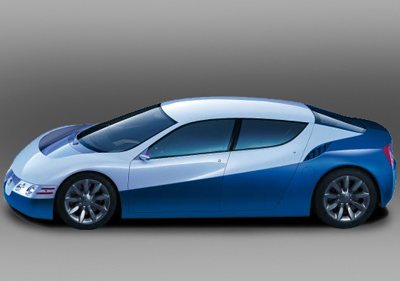
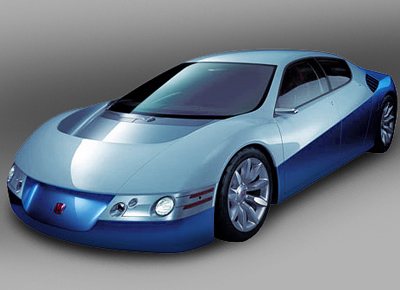
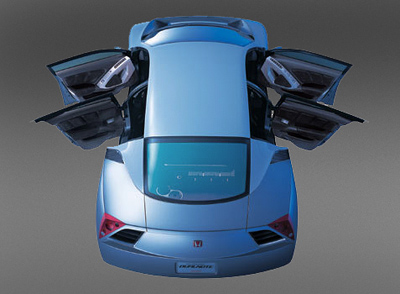
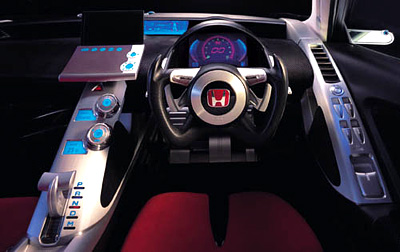
| Make | Honda |
| Model | Dualnote |
| Concept year | 2001 |
| Production year | - |
| Engine | 3.5 litre V6 and electric motors |
The Honda Dualnote was an advanced and technologically innovative concept which was first introduced at the 2001 Tokyo Motor Show.
The hybrid drive system of the Dualnote was its most important feature. It consisted of a mid mounted 3.5 litre V6 and three electric motors. In total the drivetrain produced an extremely healthy 394 horsepower, yet could also travel 50 miles (80 km) on a single gallon of fuel.
The Honda Dualnote concept also featured an all-wheel-drive system and a clutchless 6-speed sequential manual which could also be switched to full automatic mode.
In short the Dualnote concept offered outstanding straight line performance coupled with fugal fuel consumption. And thanks to the mid engine layout and 4WD system the handling wasn't bad either for a four door luxury sedan.
The interior of the Honda Dualnote featured four individual seats which were separated by a high centre console running the entire length of the passenger compartment. The instrument panel of the Dualnote was designed to deliver only the vital information when it is needed in order to improve driving pleasure and comfort. With interactive voice-recognition technology at its core, the panel is divided into 3 units: vehicle status readings via 3-D display meters, a center display that transmits extravehicular information in an expanded and easily readable form, and an information monitor for display of navigation, e-mail and other information.
The center display incorporates an arrow navigation section indicating turnings in the road ahead, a monitor that displays the presence of pedestrians picked up by the car's infrared camera at night and other functions. To minimize driver distraction, the center display is located at the bottom of the windshield.
Unfortunately while all the technology in the Dualnote was available at the time and the concept was fully engineered, the cost of the vehicle would have made it unfeasible as a production car back in 2001.
Subscribe to:
Posts (Atom)




